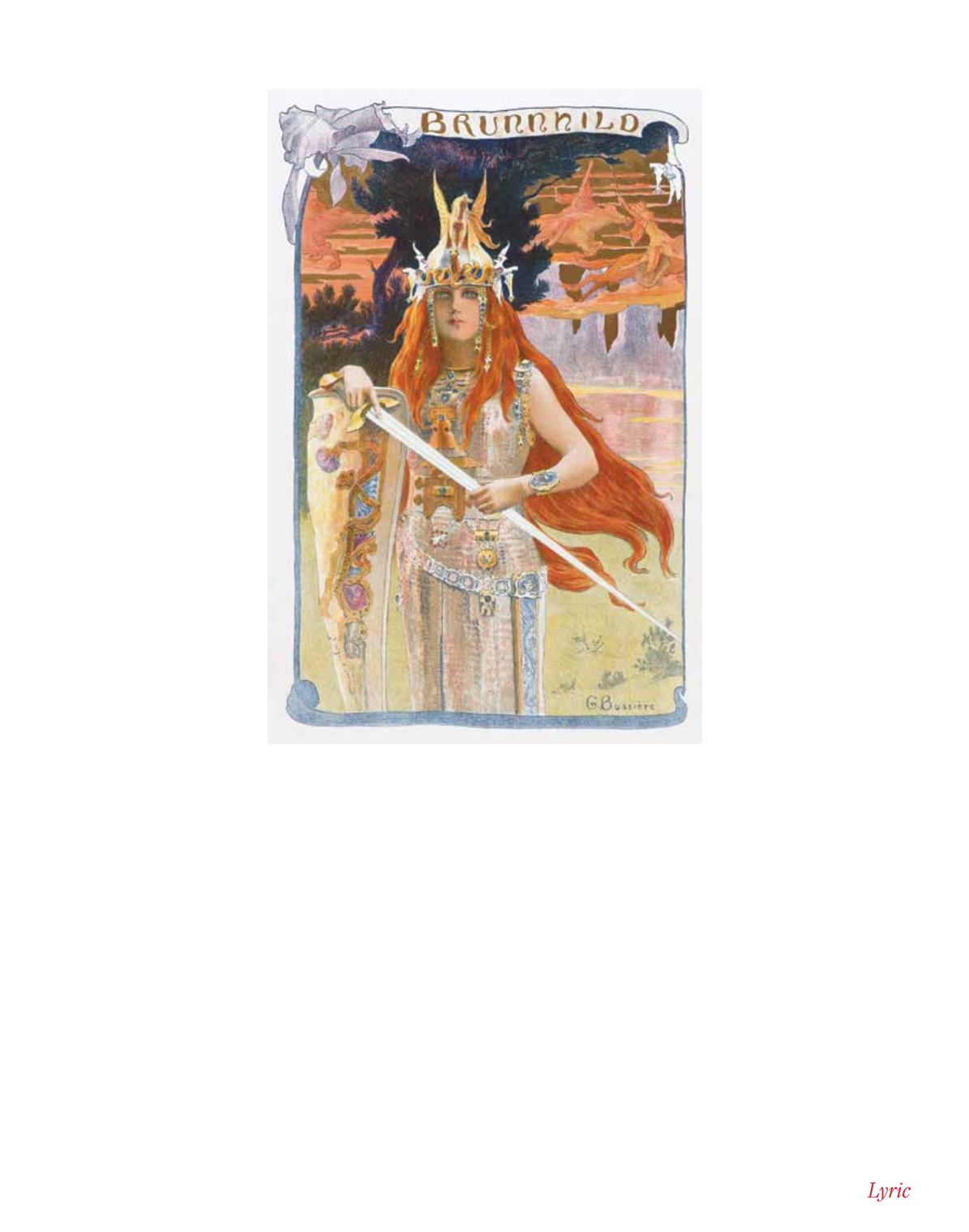

O P E R A N O T E S | L Y R I C O P E R A O F C H I C A G O
32
|
November 1 - 30, 2017
cut the Volsung kids a bit of
slack. Their relationship doesn’t
have the “ick” factor of brother-
sister lovers Jamie and Cersei
Lannister in
Game of Thrones
.
Carolyn Abate and
Roger Parker, authors of the
authoritative
A History of
Opera
, suggest Siegmund
and Sieglinde “jolted Wagner
to a higher plane in his
thinking about motifs in the
dark, those intricate musical
transformations that depict
the twins’ increasing passion.”
The authors note the Volsungs’
realization that they are related
seems “to ignite them further.”
The act hits overdrive
when Siegmund pulls Wotan’s
sword Nothung out of the ash
tree and the orchestra explodes
in triumphal light with the
themes of the sword and the
Volsungs, culminating one of
Wagner’s most rapturous love
duets. Too bad
Die Walküre
doesn’t end with the happy
pair escaping into the night.
Even an illegal marriage seems
preferable for Sieglinde than
staying with that boorish bully
Hunding.
Act Two, the second
longest of the cycle (after Act
One of
Götterdämmerung
),
challenges singers and listeners.
It returns to the musical and
dramatic darkness that pervaded the
start of the opera with a different set
of relationships. Wotan and his favorite
daughter Brünnhilde, who open the act
in high spirits, will be in bitter conflict
when the curtain closes. Wotan’s ability to
control events – even in his own family – is
shattered, starting with his wife Fricka, the
goddess of the hearth and matrimony.
A strict constructionist when it comes
to matrimonial matters, Fricka demands
that Wotan disavow the immoral Volsung
union. Audiences often view Fricka as
a righteous spoilsport, but Valhalla law
is on her side. Her music ends with a
noble reference to her “rights, sublime
and glorious,” showing Fricka, too, is an
immortal, and Wotan’s equal.
As Wotan’s plans disintegrate, for the
first time in the opera we hear the music of
Alberich’s curse –
Walküre
is the only opera
in the cycle where we never physically see
the ring. The confident and sometimes
arrogant god of
Rheingold
is losing his
mojo. In front of Brünnhilde, Wotan
delivers a lengthy narration, described
by music critic Alex Ross as “the most
spectacular psychological tailspin in the
history of opera.” The quiet, contained
music accurately portrays Wotan’s utter
dejection as he realizes the fates of the ring,
the gods and, certainly, the Volsungs are
out of his hands.
For the rest of the
Ring
cycle, this is a
humbled god.
Brünnhilde, who comes
off as spirited but somewhat
one-dimensional through the
opening of Act Two, undergoes
her own transformation in
the “Todesverkündigung,”
the announcement of death
to Siegmund, who no longer
enjoys the Valkyrie’s protection.
It is a scene of majesty and
foreboding. The music starts at
a stately pace with the Valhalla
theme, but it increases in tempo
and agitation when Siegmund
tells Brünnhilde that he will not
accompany her to the joys of
the afterlife once he learns his
“sister-bride” Sieglinde will not
be at his side.
Brünnhilde, who has never
witnessed such romantic
passion and humanity, has a
profound change of heart and
agrees to fight at Siegmund’s
side, culminating a powerful
scene that, ultimately, results
in Wotan’s favorite daughter
forfeiting her rights to be a
Valkyrie. But if Brünnhilde has
lost Wotan’s support, she has
become a more sympathetic –
dare we say human – character.
Before getting into the crux
of ActThree, a quick word about
“The Ride of the Valkyries”
that opens the act, perhaps the
most famous music Wagner
ever composed. It is accessible
enough to serve as a ditty for Elmer Fudd as
he pursues Bugs Bunny, but it also possesses
the martial quality to accompany a battle
scene in Francis Ford Coppola’s
Apocalypse
Now
. As Wagner unleashes the full power
of his large orchestra, audiences can picture
winged horses soaring over mountaintops,
ridden by a very different kind of woman.
To mid-19th century sensibilities, the
presentation of women as confident and
athletic as the brash Valkyries would have
been radical. Females didn’t behave this
way. Fricka dismisses the brood as “good-
for-nothing wenches.’’ Yet the Valkyries
are the predecessors not only of a super-
hero like Wonder Woman, but the world-
class female athletes who win Olympic and
The heroine of
Die Walküre,
extravagantly depicted
by Gaston Bussiere in 1897.
















